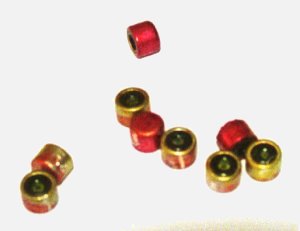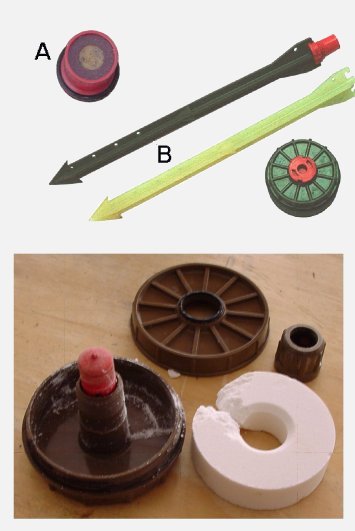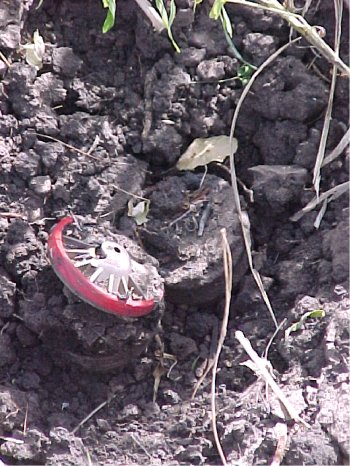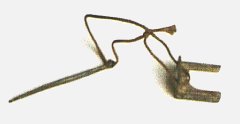Andy Smith
Mine action specialist |
|
|
AP blast mine Factsheet
R2M1/2 and Variants
|
| |
Anti-personnel blast mine, plastic cased, made in the Republic of South Africa (RSA).
The picture below shows an R2M2 made in 1976. This example was taken from Zimbabwe army stores and photographed by the author.

DESCRIPTION
The R2M2 is a small cylindrical AP blast mine with an injection moulded multi-part plastic body and initiation assembly. The pressure plate on the top of the mine has 12 radial ribs with a raised projection in the centre surrounding a protruding plunger which is red and visible as a red nipple. On the upper side of the mine body is a lightly ribbed PVC sleeve (bellows) with a short lip at the bottom and a flange at the top. The short lip is trapped between the two screw-together halves of the High Explosive chamber at the bottom of the mine, acting as a seal. The flange at the top forms the upper edge of the mine and is stiffened with a red plastic ring on the inside. A foam sponge is positioned between the pressure plate and the body cap.
The initiation assembly
Below, on the left, the metal parts and a detonator in its plastic housing.
Below, in the middle, the entire initiation assembly. The pin is visible through the clear plastic body. The detonator is set into the plastic beneath this. The spring, pin and balls are inside the red upper part.
Below on the right is a cutaway view of the stab-sensitive detonator – illustrating why it cannot be safely inerted without specialist equipment.

The three retaining balls are held in a recess in a plastic head of the pin. When the red plunger is depressed the balls align with the holes in the plunger and move to the side, allowing the spring to press down onto the plastic head of the pin and push it into the detonator.

The detonators measure 7.5mm diameter and are coated with a transparent lacquer that glues them into the clear plastic housing. In all R2M2s seen the lacquer has been red. In the TNT variants seen, the lacquer has been yellow. The difference may be deliberate or may reflect production variations.
Safety clip and booster
An unarmed mine has a safety clip inserted in a slide in the protruding centre of the pressure plate and through the groove at the top of the red plunger. This holds the plunger up.
The booster well is positioned in the centre of the base of the mine, directly beneath the detonator. The booster is shown at "A" below. The booster charge has a fibre washer on top of it. The detonator initiates the booster charge and the shock wave of its detonation initiates the main charge.
The threaded booster plug is made of red plastic and screws into the booster-well. It has a rubber O-ring washer.
Some booster plugs are varied to allow the attachment of a plastic spike, shown at "B" below. The spike is designed to prevent mine movement in washout areas.
The mine is not watertight and mines that have been buried for a long time are often found with the striker pins and/or retaining balls rusted.
The RDX and wax (8:1 ratio) fill is white.

INERTING an R2M2
First, unscrew the booster charge from the base of the mine. Then remove any safety clip that may be present. No pressure should be put on the top of the mine or the red plunger. Hold the mine by its sides.
Cut and remove the outer PVC sleeve, allowing the pressure plate and foam disc to be lifted away. The central knurled plastic boss is unscrewed and then the two halves of the mine can be separated. It is usually necessary to cut the remnants of the PVC sleeve from the join (where it forms a gasket) before the mine halves unscrew easily.
The lower part of the mine body has raised ribs on the outsides and the base. The RDX/WAX fill is a tight fit but can be removed from the smooth inner casing relatively easily.
The plunger and detonator assembly are moulded into the central pillar of the mine’s base which must be cut so that they can be withdrawn. Considerable care is needed not to initiate the detonator at this time.
The R2M2 differs from the R2M1 largely because the detonator on the R2M2 is waterproof, the plastic moulding of the booster plug is a different shape and the flexible skirt on the mine sides extends lower on the R2M1.
There is an R2M2 “TNT variant” that is a simpler and apparently cheaper model with a TNT fill. This mine cannot be separated and the case must be cut in order to expose the main charge. The fuse mechanism and detonator are identical. This R2M2 TNT variant has a 'flat' base with a raised central platform with three equally spaced circular recesses around the booster well. No picture is available at this time. The TNT variant is reported to be common in Angola .
THE SIMPLE R2M2
A further R2M2 variant has not been formally identified and is referred to as the “Simple R2”.

This mine lacks the PVC sleeve, foam disc and pressure plate. It also has a plastic clip acting as an arming pin rather than the galvanised steel clip used conventionally. A three-tined transit-cap fits over this to ensure that the clip stays in place. The lower part of the mine and its fuze mechanism are identical to the normal R2M2. This mine was located in Namibia and it is not known whether it was ever widely produced/issued.
|
R2M1 |
R2M2 |
R2M2 TNT Variant |
Height |
57 mm |
57 mm |
57 mm |
Diameter |
69 mm |
69 mm |
69 mm |
Mine weight |
130 gr. |
128 gr. |
145 gr. |
Explosive weight |
58 gr. |
58 gr. |
75 gr. |
Explosive type (main charge) |
RDX/WAX:88/12 |
RDX/WAX:88/12 |
TNT |
Booster explosive weight |
12 g |
12 g |
12 g |
Detonator explosive weight |
6.5 g |
6.5 g |
6.5 g |
Casing material and colour |
Plastic, brown, green |
Plastic, brown, green |
Plastic, green |
Fuze type |
Ball retained striker, spring pressure |
Ball retained striker, spring pressure |
Ball retained striker, spring pressure |
Sensitivity |
3-7 kg pressure |
3-7 kg pressure |
3-7 kg pressure |
Detectability |
Yes but difficult. Metal components are usually made of stainless steel: some variations occur. |
NEUTRALISING
If the top of the plunger is not visible, the spring may have been depressed and no attempt should be made to neutralise the mine. If the red plunger is clearly visible in the middle of the pressure cap, the safety clip can be slid into the groove at the top of the red plunger and the slot in the pressure plate. When the clip is in place, replace the split-pin through the clip and the holes in the pressure plate to lock it in place. This is seldom a simple operation when a mine has been in place a long time and earth has filled the clip cavity.
Mines that have been exposed for a long time harden and may split open. Several incidents involving spontaneous detonation have been reported. Do not attempt to disarm a mine that has been exposed for any length of time. Discolouration of the plastic (fading) may be the best indication of exposure and an unpredictable state.

The picture above shows an R2M2 that has split open, with a second mine (still covered) alongside it. The mine was placed not later that 1980 in the Zimbabwe/Mozambique border minefield.
DISARMING
Insert the safety clip......... .. ..
.......in the groove in the red plunger and replace the safety pin through the clip (as described under “Neutralising”. Unscrew the booster from the booster well. General advice is that the detonator cannot be removed safely. With the booster removed, the detonator can still be initiated but the main charge “should” not be initiated. The author has personal experience of one case and reports of several others in which the detonator has been initiated
without a booster and the main charge has not detonated. The detonator
is powerful enough to shatter the mine casing and cause light injuries to
exposed areas (such as the holder’s hand).
PACKING
The R2M1 and R2M2 mines are packed 40 to a plastic box. The box also contains eight containers with five boosters in each.
NOTES
The author has rendered a number of R2M2s inert. These mines had been recovered from placement in Namibia. The FFE process included cutting out the detonators without mishap.

All the mines were standard R2M2s with an RDX/Wax fill. The metal, including the retaining balls, was heavily rusted in some. The foam disk varied and the moulding of the red plunger in two cases did not allow the balls to escape as designed.
NOTE: The author does not recommend inerting mines and accepts no responsibility for errors or omissions in this factsheet. Every effort has been made to ensure that the content of the above is accurate, however there is no guarantee that any newly discovered R2M2 will be identical to those already found.
The following individuals provided advice, information or access to mines. Any failings in the above Factsheet are not their responsibility. Thanks to the late Keith Byng, Des Radmore, and to Koos Thyse.
See also: Intro to HD 3: Detecting what?
HOME
|
|
|